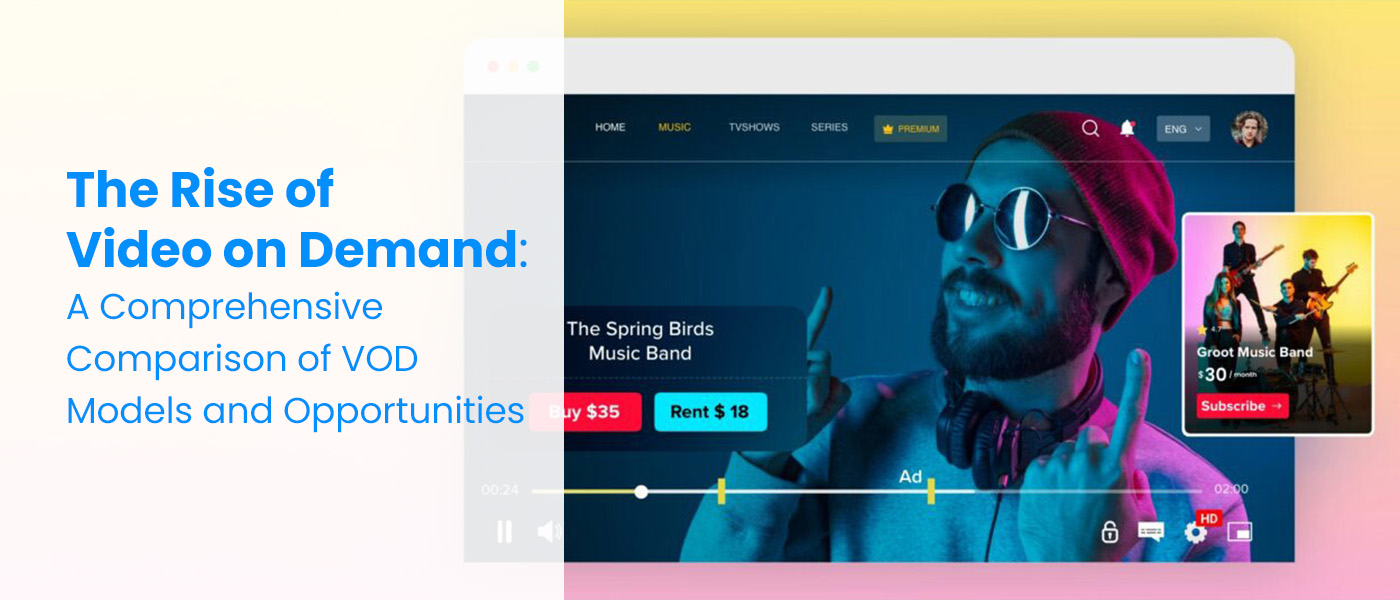Video on Demand (VOD) is transforming the entertainment industry by catering to the demand for convenience, personalization, and flexibility. Businesses and advertisers must understand the unique advantages and challenges of each VOD model to leverage this fast-evolving medium effectively. Below, we break down the key aspects of VOD models, their benefits, and their implications for advertisers in a comprehensive comparison table.
Comparison of VOD Models
| Aspect | SVOD
(Subscription Video On Demand) |
AVOD
(Advertising Video On Demand) |
TVOD
(Transactional Video On Demand) |
| Definition | Users pay a recurring fee for unlimited, ad-free access. | Users watch free or low-cost content supported by ads. | Users pay per content (rental or purchase). |
| Examples | Netflix, Disney+, HBO Max | YouTube, Tubi, Pluto TV | Apple TV, Amazon Prime (rental/purchase options) |
| Primary Revenue Source | Subscriptions | Advertisements | Pay-per-view or purchases |
| Audience Appeal | Ad-free experience, exclusive and premium content. | Free or affordable content, large variety. | Flexibility to rent or buy specific content. |
| Advantages for Users | – Unlimited access to content.
– No interruptions. |
– Free or low-cost access.
– Variety of content options. |
– No subscription commitment.
– Ad-free viewing. |
| Drawbacks for Users | – Rising costs for multiple subscriptions.
– Fragmented availability of content across platforms. |
– Interruptive ads.
– Limited access to premium content. |
– Expensive for frequent use.
– Rentals are temporary. |
| Opportunities for Advertisers | Limited direct ad opportunities but potential for sponsorships and product placement. | Extensive ad placements and precise targeting options. | Promotion of new releases or exclusive content. |
| Challenges for Advertisers | Limited access to audiences due to ad-free nature. | Ad interruptions may reduce audience engagement. | High competition for user attention across platforms. |
Read also: Advanced Audience Targeting Methods on CTV
Additional Factors Influencing VOD’s Success
| Category | Connected TV (CTV) | Over-The-Top (OTT) | Performance TV |
| Definition | Internet-connected televisions or streaming devices like Roku, Amazon Fire Stick. | Content is delivered via the internet across various devices. | Digital TV advertising platforms optimized for data-driven campaigns. |
| Audience Reach | Household-based targeting with immersive campaigns. | Multi-device accessibility broadens audience reach. | Combines the scale of TV with precise digital marketing tools. |
| Advertising Benefits | – Detailed viewer insights.
– High engagement on large screens. |
– Accessible across devices.
– Real-time audience data. |
– Automated optimization.
– Accurate tracking with verified visits. |
| Key Challenges | Balancing ad frequency and viewer experience. | Diverse device types can complicate targeting. | Requires creative tailoring and continuous data monitoring. |
How Advertisers Can Maximize Opportunities Across VOD Models
| VOD Model | Advertising Approach |
| SVOD | Use sponsorships, branded integrations, and product placements to organically align with exclusive content. |
| AVOD | Leverage advanced targeting tools to deliver personalized ads that minimize disruption and maximize relevance. |
| TVOD | Focus on promoting specific, high-demand content like new releases or exclusive premieres to attract niche audiences. |
| Performance TV | Use automation and data insights to craft campaigns that resonate with household-level viewing habits. |
Why VOD Is the Future of Entertainment and Advertising
VOD is revolutionizing how audiences consume content and how brands engage with them. By understanding the strengths and challenges of each model, businesses can craft strategies that resonate with target audiences and achieve measurable success. Whether you’re leveraging ad-supported AVOD platforms or premium SVOD services, the opportunities to connect with engaged viewers have never been greater.
Ready to embrace the future of VOD advertising? Let’s guide you to unlock its full potential!





